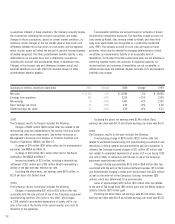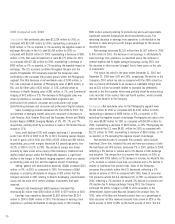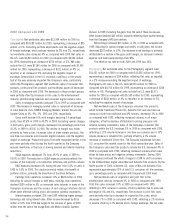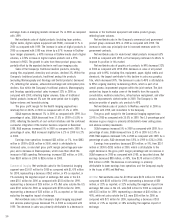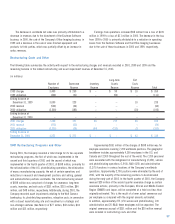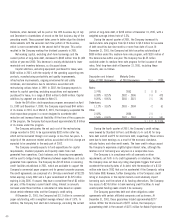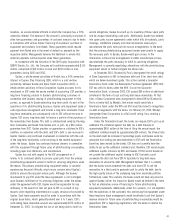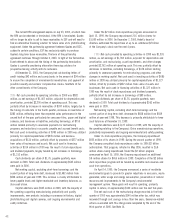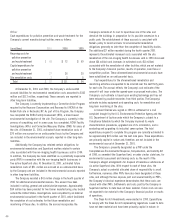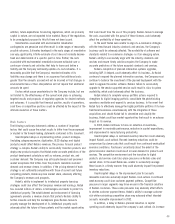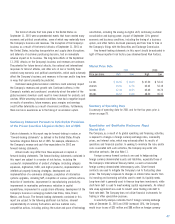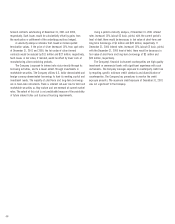Kodak 2001 Annual Report Download - page 40
Download and view the complete annual report
Please find page 40 of the 2001 Kodak annual report below. You can navigate through the pages in the report by either clicking on the pages listed below, or by using the keyword search tool below to find specific information within the annual report.
38
The Company included $119 million of the $698 million provision in
cost of goods sold, representing an $84 million inventory write-down
associated with product line discontinuances and $35 million related to
accelerated depreciation on assets presently used in operations which
were disposed of during the latter part of 2001 or will be disposed of
through abandonment within the first three months of 2002.
Also included in restructuring costs and other were write-offs and
costs associated with the Company’s exit from non-strategic operations
and investments, consisting of $180 million for the write-off of capital
assets, goodwill and investments, and $48 million for exit costs. The exit
costs consist principally of lease termination expenses, shutdown costs
and vendor penalty payments, which have been accrued on an
undiscounted basis.
Restructuring actions related to the Photography, Health and
Commercial segments amounted to $360 million, $43 million and
$21 million, respectively. The remaining $254 million were for actions
associated with the manufacturing, research and development, and
selling and administrative functions shared across all the segments.
The Company realized savings of approximately $50 million from
these programs in 2001. Total savings in 2002 are estimated to be $450
million from these programs. The net cash cost of these programs will be
recovered by the end of 2002. All actions under these programs will be
completed by the end of 2002.
In 2001, the Company recorded a $77 million charge associated
with the bankruptcy of the Wolf Camera Inc. consumer retail business.
This amount is reflected in restructuring costs and other.
During 2001, the Company recorded a $42 million charge
representing the write-off of certain lease residuals, receivables and
capital assets resulting primarily from technology changes in the
transition from optical to digital photofinishing equipment within the
Company’s onsite photofinishing operations. The charges for the lease
residuals and capital assets totaling $19 million have been included in
cost of goods sold. The remaining $23 million has been included in
restructuring costs and other.
1999 Program
During the third quarter of 1999, the Company recorded a restructuring
charge of $350 million relating to worldwide manufacturing and
photofinishing consolidation and reductions in selling, general and
administrative positions worldwide. Approximately $250 million of the
$350 million restructuring charge was for severance covering 3,400
worldwide positions. The geographic breakdown included approximately
1,475 employees in the U.S. and Canada and 1,925 throughout the rest
of the world. These reductions were associated with the realignment of
manufacturing (1,500) and service and photofinishing operations (870),
and the consolidation of sales and marketing (460), R&D (70) and
administrative (500) functions in various locations of the Company’s
worldwide operations.
In the second quarter of 2000, the Company reversed approximately
$44 million of severance-related costs originally recorded as part of this
program. The reversal was the result of two factors which occurred during
the second quarter. First, certain manufacturing operations originally
planned to be outsourced were retained, as cost-beneficial arrangements
for the Company could not be reached. Second, severance actions in Japan
and Europe were completed at a cost less than originally estimated.
Consequently, approximately 500 (450 manufacturing and 50 administra-
tive) fewer employees were separated. The original $350 million charge in
1999 and the $44 million reversal are included in restructuring costs and
other. Aside from the actions described above, all other projects included in
this program were effectively completed by December 31, 2000. A total of
2,900 employees were terminated under this program in 2000 and 1999.
Also included in restructuring costs and other are $90 million for
asset write-downs and $10 million for shutdown costs. These charges are
primarily for vacant buildings to be sold, equipment to be shut down and
other costs related to the Company’s sale and exit of its Elmgrove
manufacturing facility.
Restructuring actions related to the Photography, Health and
Commercial segments amounted to $106 million, $11 million and $6
million, respectively. The remaining $227 million were for actions
associated with the manufacturing, research and development, and
selling and administrative functions shared across all the segments.
The Company realized approximate savings associated with this
program of $90 million in 2000, and an additional $50 million of savings
in 2001, resulting in a total annual run rate savings of $140 million. The
net cash cost of this program was recovered in two years.
Other Cost Reductions In addition to the charges discussed above, the
Company incurred charges of approximately $18 million, $50 million and
$11 million in 2001, 2000 and 1999, respectively, for the accelerated
depreciation of certain assets which remained in use until the Company
sold its Elmgrove manufacturing facility in the second quarter of 2000,
and related relocation costs. These charges were included in cost of
goods sold. The sale of this facility did not result in a material gain or
loss to the Company.
Outlook
The Company expects 2002 to be another difficult economic year, with
full year revenues level with 2001 and some earnings improvement in
the second half of 2002. We do not expect to see any real upturn in the
economy until 2003, with a very gradual return to consumer spending
habits and behavior that will positively affect our business growth. The
Company will continue to take actions to minimize the financial impact


